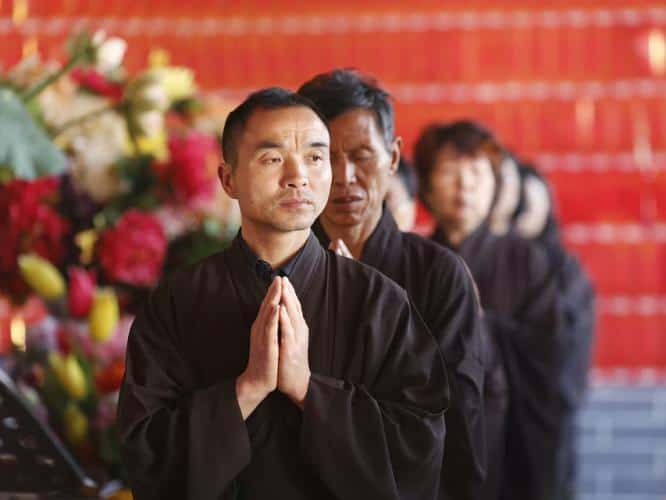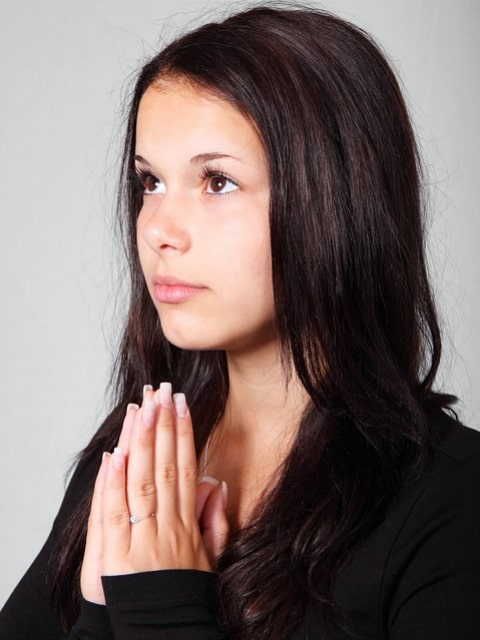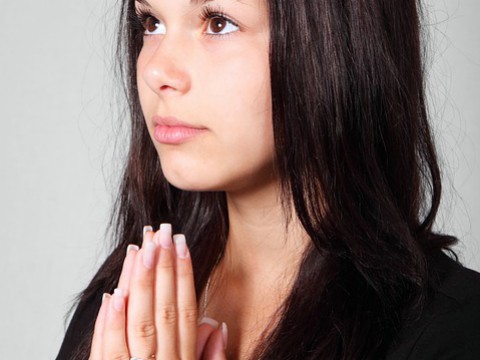Have you watched anyone bowing slightly, pressing their hands together, palms and fingers touching as they face each other, fingers pointing upwards with thumbs close to the chest? If yes, then you should know it is a form of greeting or leave-taking – called Namaste or Namaskaram.
It is an age-old Hindu custom. However, it is followed both in some parts of Western and Asian Culture. This gesture is also called the Anjali Mudra or Pranamsana.
Namaste has its roots in ancient Rigveda and Vedic Literature
The term ‘Namas’ has its roots in Vedic Literature. The term – Namas-Krita are found in Rigveda – an ancient Hindu scripture in the sense of “worship or adore.” However, the word Namaskara in the Atharvaveda is used as an “exclamatory adoration, homage, salutation and worship.” Namaskar or Namaste t is an expression of reverence, veneration or worship. Moreover, in the Vedic literature and post-Vedic texts like Mahabharata – it is an “offering of homage” or “adoration.”
You will find the term Namas-te appearing in Rigveda 8.75.10, Taittirya Samhita 2.6.11.2 and Atharvaveda verse 6.13.2. Also, found in various instances in lots of Hindu texts. Not only this, but Namaste is also found in various “ancient and medieval era sculpture and mandapa relief artwork in Hindu temples.”
The Contemporary Meaning of Namaste
In the contemporary era – Namaste (na-mah-stay) is derived for the Sanskrit dialect comprised of two words – ‘Namah’ meaning ‘bow or adoration’ and ‘te’ meaning ‘to you’. In the literal sense, the meaning of Namaste is “I bow to you” or “I bow towards you out of respect or reverence”. In Hinduism, you see the gesture reflecting the belief “the divine and self (soul) is the same in you and me.” It connotes “I bow to the divine in you.”
Holly Oxhandler, a sociologist describes Namaste as “the sacred in me recognizes the sacred in you”.
Namaste is part of the Indian culture that has a profound symbol used in occasions such as greeting elders and priests, while worshipping and praying, at a spiritual place or event and at a yoga class. You will often notice the palms and fingers come together as people meet and greet.
However, the meaning of Namaste now has a universal appeal. Almost similar to saying Amen at the end of a prayer or Maseltov to express happiness.
The gesture of Namaste also holds valuable importance in different cultures in the Asian countries as well as in the science of yoga.
“In essence, Namaste is recognizing we’re all equal.” – Yogi Sara Quiriconi from Miami

Pranamasana – A Prayer Pose
While practising Yoga – Namaskaram is the way you start and end the 12 Surya Namaskara or the Sun Salutation poses. As you gently touch your palms and fingers together it forms a prayer pose. In Sanskrit, the word ‘Pranam’ means ‘to pay respect’ and the word ‘asana’ means a ‘pose’. Thus the name Pranamasana in Yoga is where you greet and pay respects to the Sun by folding your hands.
While practising Yoga poses like Mountain Pose, Tree Pose and Standing Prayer Pose you do the pose Pranamasana or Namaste as a transitional Pose. You benefit by joining your Palms and fingers in Pranamasana to align the postures. Moreover, you can use it as a meditative pose to help you focus and deepen your breath.
However, there is more to it. Namaste is a way to “send out to the universe a message of peace and hoping to receive a positive message back.” Through yoga when you join your palms and fingers, it transcends language and culture, connecting the mind and body that helps us to look more deeply within ourselves and the world.
Articulating the word Namaste in Yoga – what we are really saying to our yoga teachers, other yogis and to ourselves is – “May my higher consciousness be united with your higher consciousness.”
Thus, we are sending vibrations of extending friendship in love, respect, and humility. As a result, Namaste gesture before and after a yoga session embraces the light as well as the darkness present within ourselves.
Namaste – A Universal Greeting
The gesture of Anjali Mudra (prayer pose) is where the palms and fingers meet and the thumbs meet at our heart chakra enabling the feelings of honour, oneness, courtesy, politeness, and hospitality directed to an individual.
This form of saluting is a tradition not only in India but in Korea as well. People in Korea fully bow to the floor to their parents and in-laws on special occasions such as weddings, engagements, and death anniversaries.
The key to the act and meaning of Namaste is helping ourselves to subdue our ego and being respectful and polite at the same time.
The Difference Between Namaste And Namaskar
You might have heard Namaskar in your yoga class or the very mention of it in the King of Yoga poses – Surya Namaskar.
Namaskar is when you greet more than one person together to show your respect and gratitude. While Namaste is greeting an individual and is a personal divine greeting.

Namaste – A Sign of Healing
In Hinduism and Buddhism traditions, the Anjali Mudra used for Namaste activates the pressure points in eyes, ear, mind. When you bring your hands together touching each fingertip to the other, it not only heals us internally. It helps us to remember the person we are greeting – their faces through our eyes, their name through our ears, and their personality through our minds.
“The divine in me honors the divine in you.”
Buddhists also believe that bowing with your hands folded acts as a cure for any negative energy, thoughts, and attachments to the ego. This binds one to Samsara (the cycle of rebirth). Namaste – the bow of respect contributes to the path away from attachment, and crushing ego.

The Spiritual Meaning of Namaste
Besides serving as a respectful greeting, Namaste is an acknowledgement respecting the divine presence in each of us. A gesture binding us and that we are all connected to one another.
The spiritual meaning of Namaste signifies the dissolving of one’s ego in the divine presence of another. That we are all same but in different forms. The belief that the divine and self is the same and the gesture of namaste is bowing down to the divine in your own being.
“When your mind is fully withdrawn in super consciousness, it becomes centered in the bliss of the spine. You are then in your ideational, or causal body. That is the level of the soul.” – Paramahansa Yogananda, author of Autobiography of a Yogi.
Saying Namaste creates vibrations and positive energy to the one receiving the gesture. It creates a little spark in your heart chakra, the source of energy – where love exists and ego disappears. Furthermore, acknowledging one’s soul to the holiness of another and paying respect to it. In fact, it recognizes the spirit of one by the soul of another. Your heart centres and chakras connect and pass positive vibrations to the one said to. This is similar to Om chanting in meditation but the vibrations encompass within you.
Gesturing Namaste means — “I honor the place in you which is of love, truth, light, and peace.” – a beautiful emotion with a spiritual touch. Also, Namaste acts as a way to ask and seek forgiveness and accept your wrongdoing.

Few of the commonly asked questions on Namaste – break the myth around the word.
Is the Meaning of Namaste – Religious?
Yes, you can rest assured – Namaste – is not a religious term. However, it is spiritual in nature evoking positive vibrations out of love.
Can we greet a younger person by the posture of Namaste?
Anyone of any age can greet any other person using the greeting pose Namaste.
BOTTOM-LINE
Namaste has a deep significance. Isn’t it? A gesture which is recognizing and respecting your soul and is elevating yet humbling. It is one of a kind, and there is no better way to respect a person than gesturing a Namaste towards her. So, the next time you meet a person, why not try Namaste instead of saying hi?
Thus, I am sure the next time you say Namaste, you will feel a sense of positive energy around you – a spiritual power of oneness.
Namaste!
Related Articles:
How to Build Awareness on Listening Mindfully Everyday
7 Tips to Save Money for the Festive Season
Crying has its Benefits – Do you know the Reason Why?
5 Tips to Practice Yoga While Travelling – making it Irresistible
Which simple Yoga poses – can improve bad Posture at work?
How to do Laughter Yoga – Step by step
Can we do Headstand Yoga Pose in the evening?
References:
https://chopra.com/articles/learn-the-meaning-of-namaste
https://www.yogajournal.com/practice/the-meaning-of-quot-namaste-quot
https://www.mindbodygreen.com/0-29229/what-does-namaste-actually-mean.html
https://www.merriam-webster.com/words-at-play/the-history-of-namaste
https://www.yogitimes.com/article/what-is-meaning-namaste-namaskar-yoga
https://www.stylecraze.com/articles/meaning-of-namaste/#gref
https://www.yogapedia.com/definition/4988/namaste
https://www.indianyogaassociation.com/blog/the-meaning-of-namaste.html
https://www.doyouyoga.com/why-do-you-say-namaste/
https://buddhaweekly.com/namaste-respect-overcomes-pride/








